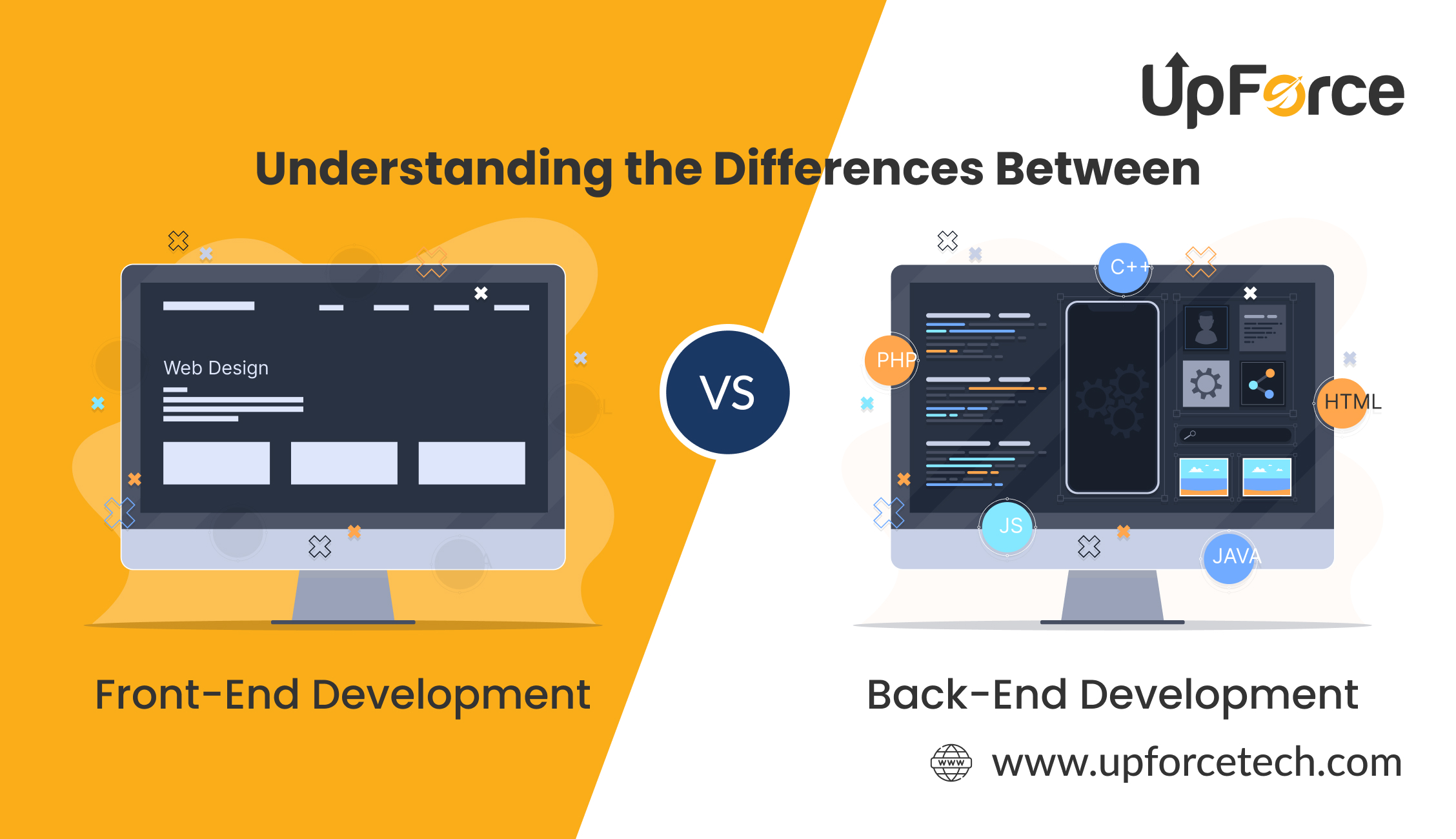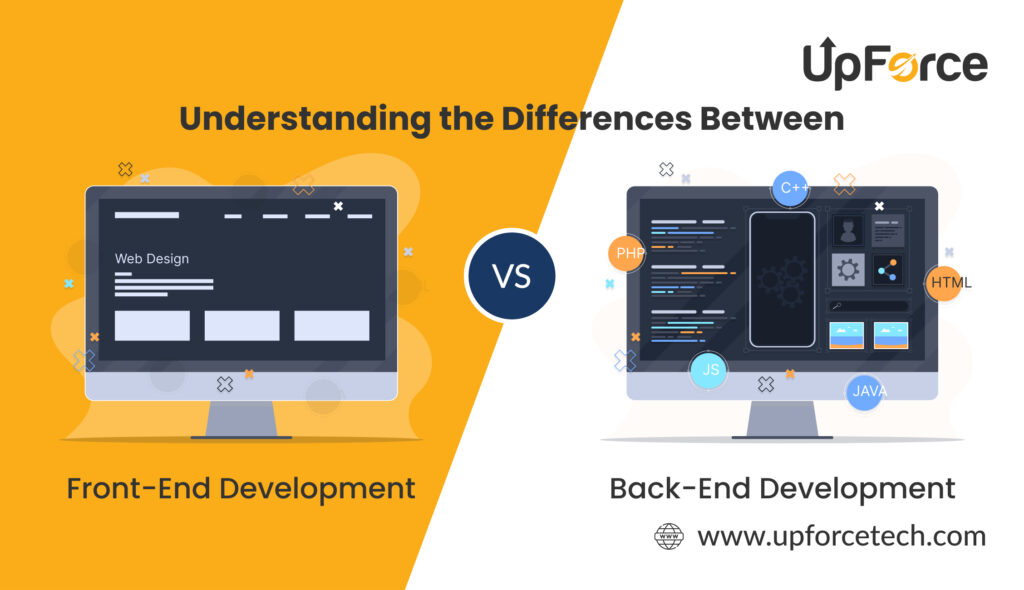Understanding the Differences Between Front-End and Back-End Development
Table of Contents
Differences Between Front-End and Back-End Development
In the digital world, where web applications drive businesses and streamline customer experiences, front-end and back-end development are crucial components. For organizations looking to build or enhance their websites or applications, understanding the differences between front-end and back-end development can help in making more informed decisions. In this article, we’ll dive deep into what these roles entail and how they work together to create seamless user experiences.

In software and web development, two distinct yet interrelated components are crucial to every web or app project: front-end and back-end development. Understanding the differences between these two will help businesses align their goals with the technology required for successful project completion.
At Upforce Tech, we understand these differences and provide the best front-end and back-end development solutions tailored to your needs. Whether you’re building a simple website or a complex application, we have developers who can ensure both front-end and back-end work seamlessly together.
What is Front-End Development?
Front-end development refers to the part of the website or application that users interact with directly. It’s often called the “client-side” of development. Front-end developers focus on how a website or application looks and behaves in response to user actions.
The primary goal of front-end development is to create an intuitive and attractive interface. This involves designing layouts, ensuring responsive design for different devices, and making sure that web pages load quickly.
Common tools and languages used in front-end development include:
- HTML: For structuring content.
- CSS: For styling and design.
- JavaScript: For interactive elements like sliders, forms, and pop-ups.
- Frameworks and Libraries: React.js, Angular.js, and Vue.js are popular choices for dynamic and modern web apps.
The success of front-end development hinges on ensuring that the user experience is smooth, responsive, and visually appealing.
What is Back-End Development?
Back-end development, also known as server-side development, powers the part of the application that users do not see. It’s responsible for managing the server, database, and any business logic that goes into the functionality of the application.
Back-end developers ensure that the website or application can handle requests from the front-end, process them, and return the appropriate information. A strong back-end ensures the overall functionality, security, and scalability of a digital product.
Back-end development involves:
- Databases: Storing and managing data.
- Servers: Hosting the website or application.
- APIs: Connecting the front-end with the server and database.
- Programming Languages: Python, Ruby, Java, PHP, Node.js, etc.
Back-end developers focus on ensuring data flow, security, and the efficiency of server-side operations, ensuring the application performs well under various conditions.
Key Differences Between Front-End and Back-End Development
Despite working towards a common goal, front-end and back-end development have significant differences in their focus areas, technologies, and approaches. Let’s explore some of the key differences:
| Feature | Front-End Development | Back-End Development |
|---|---|---|
| Focus | User interface and experience | Database, server, and application logic |
| Languages | HTML, CSS, JavaScript | Python, Ruby, PHP, Java |
| Frameworks | React.js, Vue.js, Angular.js | Django, Flask, Spring, Node.js |
| Tools | Web browsers, developer tools | Databases, servers, APIs |
| Responsibilities | Designing and building UI, improving UX | Managing server-side logic, database handling |
The Role of Front-End Developers
Front-end developers play a pivotal role in ensuring a website or application is visually appealing and easy to use. Their primary responsibility is to convert designs into functional web interfaces using coding languages like HTML, CSS, and JavaScript.
Core tasks of front-end developers include:
- Responsive Design: Ensuring websites work on all devices (mobile, desktop, tablet).
- Performance Optimization: Reducing load times and improving user interaction.
- Accessibility: Making sure that the application is usable for people with disabilities.
- Cross-browser Compatibility: Ensuring the application functions properly across different browsers.
The front-end development process requires attention to detail and user-centric thinking to ensure a high-quality user experience.
The Role of Back-End Developers
Back-end developers are responsible for the behind-the-scenes functionality that powers an application. This includes server management, database design, and creating APIs that the front-end communicates with.
Key responsibilities of back-end developers include:
- Database Management: Storing and retrieving data securely.
- Server Maintenance: Keeping the server operational, secure, and efficient.
- API Development: Creating endpoints for the front-end to interact with.
- Security Implementation: Ensuring that user data is protected.
Back-end developers ensure the website or app is functional, scalable, and secure, regardless of the number of users or volume of data.
How Front-End and Back-End Development Work Together
Front-end and back-end development are not isolated processes. They need to work together for the website or application to function as intended. Communication between the two ensures:
- Data Flow: The front-end sends user inputs to the back-end, which processes them and returns the appropriate results.
- Real-time Interactions: APIs enable front-end users to interact with the back-end to update data without reloading the page (e.g., submitting forms, posting comments).
- Consistency: While the front-end displays data, the back-end ensures that the data is accurate, secure, and up-to-date.
At Upforce Tech, we specialize in ensuring smooth collaboration between front-end and back-end teams, providing you with a seamless product.
Technologies Used in Front-End and Back-End Development
The modern web is built using a wide range of technologies for both front-end and back-end development. Here’s a breakdown of commonly used tools in each:
-
Front-End:
- Languages: HTML, CSS, JavaScript
- Frameworks: React.js, Angular.js, Vue.js
- Tools: Bootstrap, Sass, Tailwind CSS
-
Back-End:
- Languages: Python, Ruby, PHP, Java, Node.js
- Frameworks: Django, Flask, Spring, Express.js
- Databases: MySQL, PostgreSQL, MongoDB, Firebase
By using the right combination of these technologies, Upforce Tech ensures that your project is built to last.
Challenges in Front-End and Back-End Development
Despite their importance, both front-end and back-end development come with their own set of challenges:
-
Front-End Challenges:
- Ensuring cross-browser compatibility
- Handling performance optimization
- Managing responsive designs for various devices
-
Back-End Challenges:
- Scaling the server to handle increased traffic
- Securing data and protecting user privacy
- Ensuring smooth data flow between the front-end and back-end
At Upforce Tech, our team is well-versed in overcoming these challenges and providing reliable solutions for your business.
Case Study 1: E-commerce Platform
Client: A growing online retailer.
Challenge: The client wanted to develop an e-commerce platform with an intuitive interface for users while also handling large volumes of traffic and transactions securely.
Solution: Upforce Tech deployed a team of front-end and back-end developers to work on the platform.
-
Front-End Development: The front-end team created a responsive and visually appealing design using React.js to ensure that the site worked well across devices (mobile, tablet, desktop). They focused on simplifying the user experience, making product discovery, and checkout processes seamless.
-
Back-End Development: The back-end team built a robust system using Node.js and MongoDB to handle the large database of products, user accounts, and transactions. They implemented secure payment gateways, ensuring the safety of users’ financial data. The back-end was also optimized for scalability, so the platform could handle increased traffic during peak shopping times, such as Black Friday.
Outcome: The retailer saw an increase in customer retention and sales due to the smooth and secure shopping experience. The responsive design also helped capture mobile shoppers, leading to a 25% increase in mobile transactions within the first three months.
Case Study 2: Custom CRM Development
Client: A medium-sized B2B service provider.
Challenge: The client needed a custom Customer Relationship Management (CRM) tool to manage leads, track sales activities, and streamline customer support.
Solution: Upforce Tech designed and developed a full-stack CRM application from scratch.
-
Front-End Development: Using Vue.js, the front-end developers designed a clean, user-friendly interface that allowed sales teams to manage their leads and tasks easily. The design was intuitive, with a focus on reducing the learning curve for new users. Features like drag-and-drop lead management, customizable dashboards, and real-time notifications improved user efficiency.
-
Back-End Development: On the back-end, Upforce Tech utilized Django (Python) to handle data management and implement features like role-based access control, reporting tools, and lead scoring algorithms. The back-end was integrated with the company’s existing databases, allowing seamless data migration and integration with other tools like email marketing platforms.
Outcome: The client experienced a significant improvement in operational efficiency. The sales team could manage leads and customer data more effectively, leading to a 30% increase in lead conversions within six months of implementation.
Case Study 3: Fitness App Development
Client: A fitness startup.
Challenge: The client aimed to create a fitness app that offered real-time workout tracking, personalized workout plans, and social features to engage users.
Solution: Upforce Tech provided a full-stack development solution, covering both the front-end user experience and the back-end functionalities.
-
Front-End Development: The app’s front-end was developed using React Native to ensure cross-platform compatibility for iOS and Android. The user interface was designed to be clean and engaging, with features like swipeable workout plans, real-time progress tracking, and social sharing options.
-
Back-End Development: On the back-end, Upforce Tech used Firebase for real-time data synchronization and user authentication. This enabled users to track their workouts in real-time and store data securely. The back-end also managed personalized workout recommendations based on user data, including fitness levels and goals.
Outcome: The fitness app gained 50,000 users in its first three months and maintained a high engagement rate due to its smooth functionality and real-time features. The app’s back-end handled the influx of new users seamlessly, with no downtime or data security issues.
How UpforceTech Can Help You Hire the Right Contract Developer
At UpforceTech, we specialize in connecting businesses with highly skilled contract developers who can meet their unique needs. Our rigorous vetting process ensures that you get access to the best talent, whether you need someone with expertise in front-end development, back-end systems, or mobile app development.
Here’s how UpforceTech can support your business:
- Access to a Global Talent Pool: We provide access to a diverse range of developers from around the world, ensuring you find the right fit for your specific project needs.
- Customized Hiring Solutions: Whether you’re looking for short-term contract developers or long-term project-based teams, we tailor our services to fit your requirements.
- Quality Assurance: Every developer in our network goes through a comprehensive screening process to ensure they have the necessary skills and experience to deliver high-quality work.
- Ongoing Support: Our commitment doesn’t end with hiring. We offer ongoing support to ensure a seamless integration of contract developers into your team.
For more information on how to get started with hiring contract developers, visit UpforceTech.
Looking to grow your business with skilled developers? Hire a contract developer today to bring fresh ideas and expertise to your team. Learn how UpforceTech can help!
Sign up for the free Newsletter
Successful web development relies on the perfect synergy between front-end and back-end—creating experiences that are both beautiful and powerful.
UpforceTech
FAQs
Front-end focuses on the user interface, while back-end handles server-side logic and databases.
Yes, this is known as full-stack development.
Both are equally important for a fully functional website or application.
Yes, JavaScript is used for both client-side (front-end) and server-side (back-end) development through frameworks like Node.js.
HTML, CSS, JavaScript, and experience with front-end frameworks like React or Angular.
Knowledge of server-side programming languages (e.g., Python, PHP), databases, and API integration.
A full-stack developer is skilled in both front-end and back-end development.
Front-end developers handle user-facing elements, while back-end developers manage the data and logic behind the scenes.
React.js, Angular, and Vue.js are widely used in front-end development.
Node.js, Django, and Laravel are among the most popular back-end frameworks.

